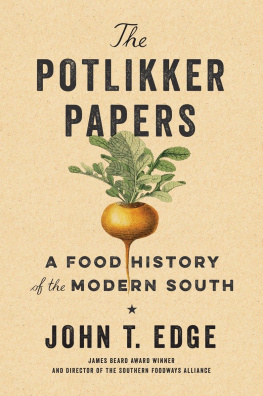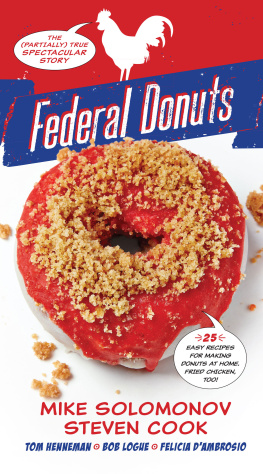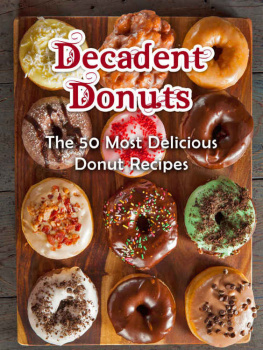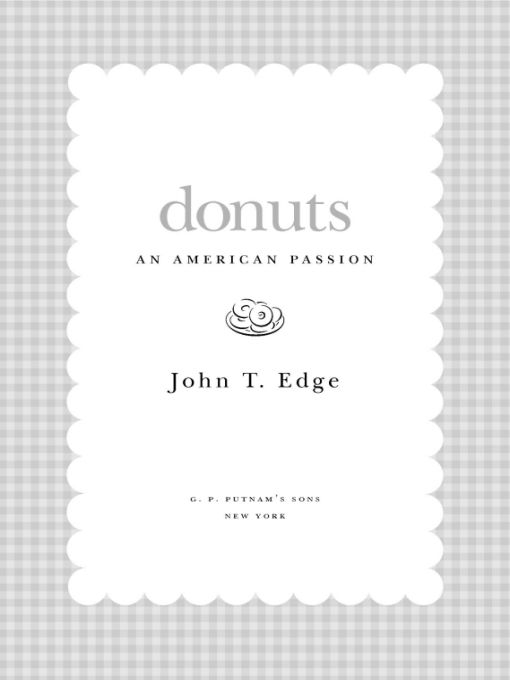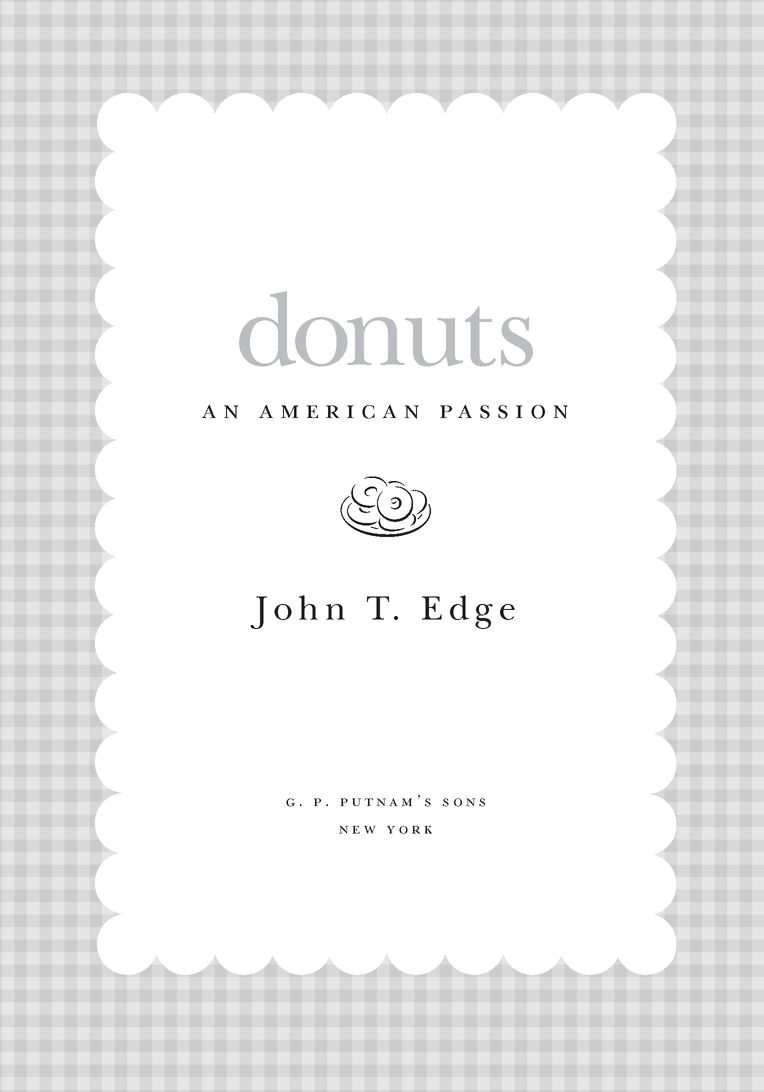Table of Contents
ALSO BY JOHN T. EDGE
Fried Chicken: An American Story
Apple Pie: An American Story
Hamburgers & Fries: An American Story
FOR MY MOTHER,
THE LATE MARY BEVERLY EVANS EDGE
the doughnut is the dumb blonde of the pastry world. Buoyant and pillowy as a breast implant.
JILL LIGHTNER, Seattle Weekly
the donut is the street thug of the pastry world, strutting past Madeleine and clair.
PATRIC KUH, Los Angeles magazine
Series Introduction
This is the final in a four-book series that celebrates Americas iconic foods. Fried chicken led off; then, in quick succession, came apple pie and hamburgers. Now donuts. To my mind, these are small-d democratic foods that conjure our collective childhood and call to mind the question once posed by a Chinese philosopher: What is patriotism, but nostalgia for the foods of our youth?
I chose these foods because they transcend interregional variation and internecine debate about origin. Recognized from the Atlantic to the Pacific as uniquely American, they evoke the culinary and cultural fabric of our nation.
Though the places profiled and the recipes detailed can be read as keys to good eats, my intent was not to compile a list of the countrys top spots. Instead, in this book and the ones that accompany it, I strive to showcase a crazy quilt of American passions.
PREFACE
Conflicted About Krispy Kreme
the date is October 24, 2001. My fax machine unspools a note from Peter McKee, a Seattle friend, annotated with an article from his local alternative weekly. The city is six days shy of its first Krispy Kreme store and Peter, who came to love the yeast-raised rounds while working as a legal aid attorney in 1970s Georgia, is atwitter. He has begun cloaking himself in the goods of the brand. He has a T-shirt blazoned with green and red Krispy Kreme cursive. And he possesses a Krispy Kreme hat, one of those paper skiffs imprinted with the exuberant company logo.
Peter is a man obsessed. His enthusiasm is guileless, infectious. But unlike some of his fellow citizens, he understands the cultural clash signaled by Krispy Kremes arrival. Along the bottom of an article from the Seattle Weekly entitled Screw Krispy Kreme, Peter scrawled his own analysis: The backlash has begun!
Jill Lightner, author of the article, sees the arrival of Krispy Kreme as indicative of an American tendency toward brand over product and conformity over quality. She argues that Seattle possesses its own donut culture. Why fall for some import? Krispy Kreme offers a consistently adequate product throughout the country, writes Lightner, and as of 5:30 a.m. on October 30, Seattleites will be lining up to receive their doses of fresh, hot adequacy.
Lightners question is one of provincial pride. She wonders whats to keep Krispy Kreme from goose-stepping across the continent, wrecking mom and pop donut shops, paving the hinterlands with official-issue Winston-Salem glaze. Her implied patsy is a nation of lemmings posed as gourmands, standing in line at 5:30 in the morning for models of throughput, mass-produced donuts.
Over the course of a couple years of fried dough eating, I will discover that Lightner is not alone. Donuts, it seems, are not defined solely by sweetness and light. Love them a little too much, and people question your devotion. Fetishize them, and people question your discernment.
Whats more, I will learn that no donut company is as proficient at cultivating devotion as Krispy Kreme. From 1996, when Krispy Kreme opened a retail store in Manhattan and Roy Blount, Jr., laid it on thick for The New York Times Magazine , declaring that they are to other doughnuts what angels are to people, through 2004, when fried-dough fatigue set in and Krispy Kremes stock price began to tank, the company appeared an unstoppable cultural and culinary force.
There were, of course, signs of ambiguity, of weakness. Blount may have foretold the companys Roman-candle rise and demise when he wrote, I hope New Yorks acceptance of Krispy Kreme is not ironic.... Like life, a hot Krispy Kreme goes by so fast that if your tongues in your cheek, you miss something.
Blount was addressing the perils of faddishness, the pitfalls of adopting style over substance. Or maybe Blount was goading us. Perhaps he intuited that, in the same manner Starbucks catalyzed patrons of our nations local coffee shops, the grand opening of each new Krispy Kreme would sweep a klieg across the rabble of Americas independent donut shops, bringing into relief the differences between homespun institutions and slick corporate edifices.
its February of 2003. Pastry chef Ann Amernick of Washington, D.C., a veteran of the White House kitchens, knows how to read the nations pulse by way of its cravings. And she doesnt like what she sees.
I arrive at her Cleveland Park shop, intent upon a donut, preferably one of those raspberry jelly ones I read about in The Washington Post. But I arrive too late in the day to purchase one of her beauties. Besides, she quit the raspberry jelly donuts a few months back, when the lines got long, the crowds unruly. Amernick is also out of Maryland strudel, a featherweight pastry burdened by apricots and currants, strafed with cinnamon. Although I did not seek her out to discuss Americas burgeoning fascination with donuts, thats what shes serving.
Krispy Kreme turned all this into a big deal, says Amernick, clad in a pressed white apron. Theyve minted this brand of people that dont have a mind of their own, she says, her aquiline nose flaring. Theyve somehow been conditioned to think of donuts as a rare commodity. They thrive on being told they cant have something. They shake their fists through the windows, cursing. All for donuts.
She reaches for a sugar cookie, turning it in her hand like a jewel. I want to tell these people, Taste this cookie, this is my aunts cookie, Amernick says. But they want donuts, donuts, donuts. These people have lost their sense of discovery; theyre following the lead of the press. They gobble my donuts like heathens and then tell me how they compare to Krispy Kreme. They dont understand that what makes my donuts light is the care with which they are made, the heart I pour into every one. They dont understand that these donuts began their life in something other than a machine. And that makes me sad.
perhaps Amernick protests too much. But in her screed I hear something familiar, a tale of Americas conflicted love affair with donuts. We love them dearly and, knowing this, loathe ourselves.
For the moment, lets set aside issues of health and allow that, compared with, say, oat bran muffins, donuts are not the centerpieces of a cardiologist-endorsed twenty-first-century breakfast. Instead, lets focus upon the form. We food fetishists rhapsodize about the symmetry, about the perfectly round figure of a mass-produced donut. And then we recoil upon realizing that, by way of these rhapsodies, we define ourselves as complicit cogs in the machine of homogeneity.


